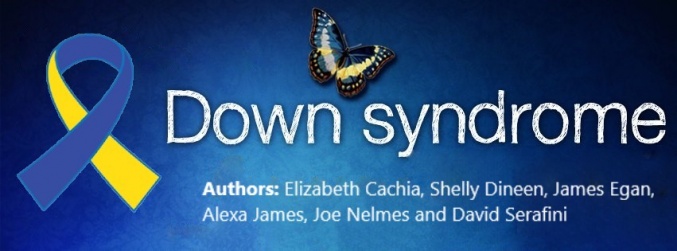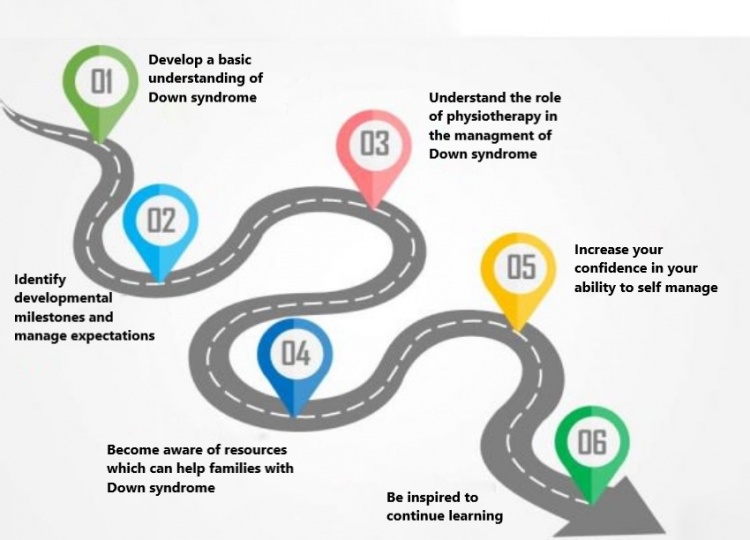Down Syndrome (Trisomy 21): Difference between revisions
No edit summary |
No edit summary |
||
| Line 6: | Line 6: | ||
Through summarization and critical analysis of current literature, it is the goal of this page to provide families of persons with DS a comprehensive, easily understood learning resource that they can feel confident in consulting. This resource further intends to educate the readers on projected expectations over the lifespan of an individual with DS, ease concerns, and highlight the role of physiotherapy in the care and management of Down syndrome. After reading this resource, it is the hope of the authors that readers will feel encouraged and confident in self-management, allowing the family to better cope at home, and be better able to understand when and how to seek professional guidance, should they require support. | Through summarization and critical analysis of current literature, it is the goal of this page to provide families of persons with DS a comprehensive, easily understood learning resource that they can feel confident in consulting. This resource further intends to educate the readers on projected expectations over the lifespan of an individual with DS, ease concerns, and highlight the role of physiotherapy in the care and management of Down syndrome. After reading this resource, it is the hope of the authors that readers will feel encouraged and confident in self-management, allowing the family to better cope at home, and be better able to understand when and how to seek professional guidance, should they require support. | ||
== Why is this Wiki Important? == | |||
DS is the most common chromosomal disease world wide, <ref>NATIONAL DOWN SYNDROME SOCIETY. 2018. Down syndrome fact sheet [online]. [viewed 14 March 2018]. Available from: www.ndss.org/wp-content/uploads/2017/08/NDSS-Fact-Sheet-Language-Guide-2015.pdf</ref> with 1 in 700 births resulting in a child with DS<ref>CIPRIANI, G., DANTI, S., CARLESI, C. and FIORINO, M., 2018. Aging with down syndrome: the dual diagnosis: alzheimer's disease and down syndrome. American Journal of Alzheimer's Disease and Other Dementias [online]. January [viewed 14 March 2018]. Available from: www.journals.sagepub.com/doi/pdf/10.1177/1533317518761093</ref>. In the UK alone, there are over 41,000 people living with down syndrome, and 750 new people born with DS each year <ref>CARR, J. and COLLINS, S. 2018. 50 years with down syndrome: a longitudinal study. Journal of Applied Research in Intellectual Disabilities [online]. March [viewed 14 March 2018]. Available from: <nowiki>https://www.ncbi.nlm.nih.gov/pubmed/29498451</nowiki></ref>. Birth rates are expected to stay the same, but the total population of persons with DS is expected to rise in the coming years. This is mainly due to medical advancements which have increased the life expectancy of people with DS from age 9 in 1929, to 60 years of age today <ref>ZHU, J., HASLE, H., CORREA, A., SCHENDEL, D., FRIEDMAN, J., OLSEN, J. and RASMUSSEN, S. 2013. Survival among people with down syndrome. Genetics in Medicine [online]. vol. 15, pp. 64-69 [viewed 12 March 2018]. Available from: <nowiki>https://www.nature.com/articles/gim201293</nowiki> </ref>. With this increase in number and age of this population, there will be larger demand on health services and increased challenges for families to overcome. Futhermore, persons with DS already report having problems gaining access to health care<ref>ALLERTON, L. and EMERSON. E., 2012. British adults with chronic health conditions or impairments face significant barriers to accessing health services. ''Public Health'' [online]. vol. 126, pp. 920-927 [viewed 13 March 2018]. Available from: <nowiki>https://www.ncbi.nlm.nih.gov/pubmed/22959282</nowiki></ref> with the main barier being a lack of knowledge about available services<ref>NATIONAL HEALTH SERVICE., 2006. ''Promoting access to healthcare for people with a learning disability''. [viewed 14 March 2018]. Available from: www.jpaget.nhs.uk/media/186386/promoting_access_to_healtcare_for_people_with_learning_disabilities_a_guide_for_frontline_staff.pdf</ref>. | |||
This wiki is therfore a necessary educational tool for families to consult whenver they have question and are unable to reach a health service. It will also teach families of individuals with DS what is to be expected over the life span of a person with DS and how to best self manage at home. Lastly, this page is important to provide support resources for family members to contact should they require assistance. | |||
== Learning Journey == | == Learning Journey == | ||
| Line 11: | Line 16: | ||
== What is Down Syndrome? == | == What is Down Syndrome? == | ||
== Developmental Milestones == | == Developmental Milestones == | ||
Revision as of 02:35, 17 March 2018
Introduction[edit | edit source]
Welcome to our information page. This resource is intended for families of persons with Down syndrome (DS). It is common for members of families containing an individuals with DS to conduct research to better understand the unique challenges they may face, or to prepare for what the future my hold. There is a large number of resources available surrounding Down snydrome, and this can be overwhelming and intimidating. The purpose of this learning resource is to consolidate this information into one page, clarify the key aspects and make learning easier.
Through summarization and critical analysis of current literature, it is the goal of this page to provide families of persons with DS a comprehensive, easily understood learning resource that they can feel confident in consulting. This resource further intends to educate the readers on projected expectations over the lifespan of an individual with DS, ease concerns, and highlight the role of physiotherapy in the care and management of Down syndrome. After reading this resource, it is the hope of the authors that readers will feel encouraged and confident in self-management, allowing the family to better cope at home, and be better able to understand when and how to seek professional guidance, should they require support.
Why is this Wiki Important?[edit | edit source]
DS is the most common chromosomal disease world wide, [1] with 1 in 700 births resulting in a child with DS[2]. In the UK alone, there are over 41,000 people living with down syndrome, and 750 new people born with DS each year [3]. Birth rates are expected to stay the same, but the total population of persons with DS is expected to rise in the coming years. This is mainly due to medical advancements which have increased the life expectancy of people with DS from age 9 in 1929, to 60 years of age today [4]. With this increase in number and age of this population, there will be larger demand on health services and increased challenges for families to overcome. Futhermore, persons with DS already report having problems gaining access to health care[5] with the main barier being a lack of knowledge about available services[6].
This wiki is therfore a necessary educational tool for families to consult whenver they have question and are unable to reach a health service. It will also teach families of individuals with DS what is to be expected over the life span of a person with DS and how to best self manage at home. Lastly, this page is important to provide support resources for family members to contact should they require assistance.
Learning Journey[edit | edit source]
It is the goal of the authors, that after reading this page you will:
What is Down Syndrome? [edit | edit source]
Developmental Milestones[edit | edit source]
References[edit | edit source]
see adding references tutorial.
- ↑ NATIONAL DOWN SYNDROME SOCIETY. 2018. Down syndrome fact sheet [online]. [viewed 14 March 2018]. Available from: www.ndss.org/wp-content/uploads/2017/08/NDSS-Fact-Sheet-Language-Guide-2015.pdf
- ↑ CIPRIANI, G., DANTI, S., CARLESI, C. and FIORINO, M., 2018. Aging with down syndrome: the dual diagnosis: alzheimer's disease and down syndrome. American Journal of Alzheimer's Disease and Other Dementias [online]. January [viewed 14 March 2018]. Available from: www.journals.sagepub.com/doi/pdf/10.1177/1533317518761093
- ↑ CARR, J. and COLLINS, S. 2018. 50 years with down syndrome: a longitudinal study. Journal of Applied Research in Intellectual Disabilities [online]. March [viewed 14 March 2018]. Available from: https://www.ncbi.nlm.nih.gov/pubmed/29498451
- ↑ ZHU, J., HASLE, H., CORREA, A., SCHENDEL, D., FRIEDMAN, J., OLSEN, J. and RASMUSSEN, S. 2013. Survival among people with down syndrome. Genetics in Medicine [online]. vol. 15, pp. 64-69 [viewed 12 March 2018]. Available from: https://www.nature.com/articles/gim201293
- ↑ ALLERTON, L. and EMERSON. E., 2012. British adults with chronic health conditions or impairments face significant barriers to accessing health services. Public Health [online]. vol. 126, pp. 920-927 [viewed 13 March 2018]. Available from: https://www.ncbi.nlm.nih.gov/pubmed/22959282
- ↑ NATIONAL HEALTH SERVICE., 2006. Promoting access to healthcare for people with a learning disability. [viewed 14 March 2018]. Available from: www.jpaget.nhs.uk/media/186386/promoting_access_to_healtcare_for_people_with_learning_disabilities_a_guide_for_frontline_staff.pdf








